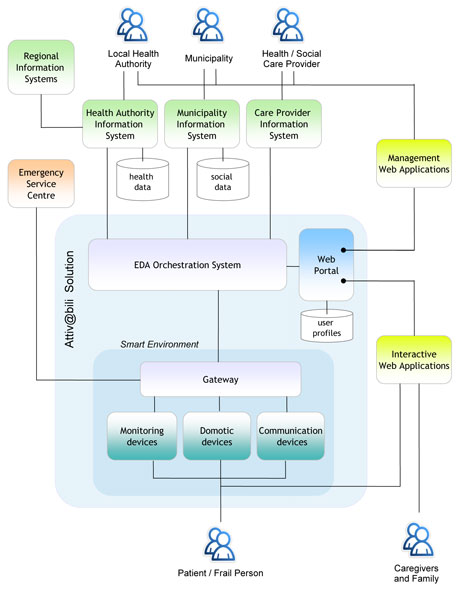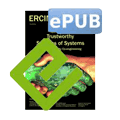by Mariagrazia Fugini, Federica Cirilli and Paolo Locatelli
The Italian Project “Digital Support and Social Innovation in Controlled Environments - Attiv@bili”, funded by the Region of Lombardy, proposes innovative organizational and ICT models for the care of frail individuals (e.g. the elderly and people with disabilities). These individuals require both health and social services (integrated care), preferably at home.
The number of frail individuals, in particular elderly people and people with disabilities, requiring assistance is increasing rapidly, creating a critical situation for health and social services management. As far as possible, these people should be cared for in their own homes. ICT tools and home automation devices can play an important role here, increasing the quality of life and promoting social inclusion.
The Attiv@bili project is developing tools that support the provision of health and social care services in the home. The focus is on process coordination between organizations and on integrated ICT solutions, both seen as key factors in achieving effective information exchange between all those involved (individuals and agencies) in care provision.
Attiv@bili
Attiv@bili aims at: (i) sustainability, requiring small investments in new technologies and few organizational changes; (ii) health and social care integration, through information systems and acquisition of data about health, behaviour, social activities and responsiveness of patients at home and in assisted residential living; (iii) end-to-end services for key groups of patients; (iv) flexible hardware and software solutions that can be personalized locally; (v) services that are scalable according to population demand; (vi) strengthened organizational initiatives, introducing process best practices to guide the project.
These targets are achieved through networked information systems and data acquisition devices in the home. End-to-end services and macro-classes of patients are taken into account; however, the proposed solutions aim at respecting specificities and individual levels of acceptance and need for privacy.
Attiv@bili begins by gathering data in the home in four distinct areas: (i) Ambient Intelligence; (ii) Interactive media (e.g. interactive television); (iii) Body Area Sensors; (iv) Smart assistance systems (e.g. voice recognition systems, automatic reminders and alert functions).
Attiv@bili fosters digital process support and the sustainable integration of different actors involved in social assistance and care through: (i) extension of the capabilities of existing solutions; (ii) sharing of dedicated systems between actors operating on care processes; (iii) integration of services and information within each process step, managed by different information systems.
The core of the integration model is a backbone platform conveying data from devices for ambient automation and orchestrating process components. The platform is designed to use limited resources and to support integrated care processes.
From an organizational viewpoint, Attiv@bili develops a set of Key Performance Indicators and coordination mechanisms through which operations of the various actors can be aligned dynamically.
Framework
The ICT solution in Attiv@bili is a service-oriented and event-driven platform [2], including an Orchestration and Integration System made of workflows and services for information sharing, alerts, ambient control commands and monitoring (see Figure 1). It acts as a flexible orchestrator across different actors connected through their information systems via software adapters. New actors/systems could be integrated by developing a suitable adaptor. Cooperation between different information systems occurs through signals and contextualized information, according to specific events. For example, the need for a new care plan by a Local Healthcare Authority is transmitted through an alert to a certified care provider via Attiv@bili: visits to the patient’s home will automatically generate feedback via the information systems made interoperable via the Attiv@bili platform.

Figure 1: Collaborative software architecture in the Attiv@bili solution.
Integration between sensors and monitoring tools at patients’ homes or in residential complexes guarantees continuity of care among care providers. The Gateway currently connects a smart watch, a number of domotic devices (totems) and communication devices (web browsers or smart devices). The Gateway will be connected to an Emergency Service Centre. The Web Portal shows administrative and advanced (smart care) services. Attiv@bili includes two types of application modules: applications for the actors of care service management processes, and applications providing interactive services to the assisted subjects/caregivers. The Portal interacts with the orchestration system to manage user profiles, and is an access point for third parties providing additional services (e.g. ordering medical supplies).
Prototype
The prototype is currently being activated by local public health authorities and care service providers. Meanwhile, pilot environments are being set up with home devices to cater for different kinds of patient needs and in different living settings, from private homes to residential complexes, both in rural and urban areas.
Attiv@bili is funded by the by the Region of Lombardy within the Smart Cities 2007-2013 Regional Development Structural Funds of the European Union. The project partners include Linea Com Srl, Politecnico di Milano, GPI Spa, Consoft Systems Spa, Fluidmesh Networks Srl, Ancitel Lombardia, Microdevice Srl, Studiofarma Srl and two non-profit organizations for health and social care services in Lombardy.
References:
[1] G. Okeyo, Li. Chen, H. Wang: “Combining ontological and temporal formalisms for composite activity modelling and recognition in smart homes”, Future Generation Computer Systems, vol. 39, Oct. 2014, pp. 29-43.
[2] A. Mouttham, et al.: “Event-driven data integration for personal health monitoring”, Journal of Emerging Technologies in Web Intelligence 1.2 (2009): 110-118.
Please contact:
Mariagrazia Fugini - Politecnico di Milano, Italy
Tel: +39-02-23993624
E-mail:











